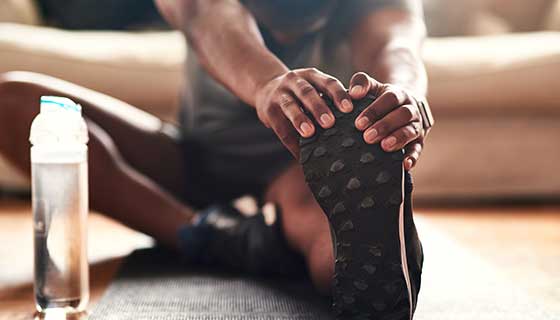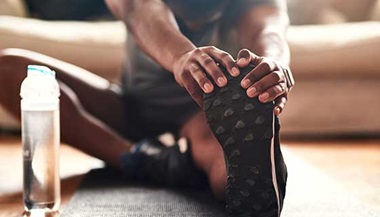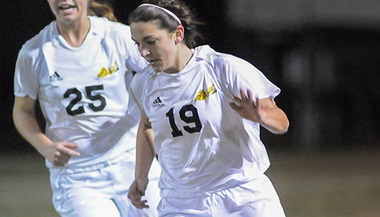Patient Story
Kei'moni's Story: ACL Reconstruction

Patient Story Highlights
- Kei'moni, a 12-year-old boy who loved playing football and basketball, discovered that he was born without anterior cruciate ligaments (ACLs) in both knees after experiencing recurring knee pain.
- A pediatric sports medicine program at Johns Hopkins All Children’s Hospital performed specialized ACL reconstruction surgery on Kei'moni, which involved taking a graft from another part of his leg and placing it into his knee.
- This minimally invasive arthroscopic surgery is a new technique that doesn't damage the growth centers in the knee, which was an issue in the past.
Kei’moni loves to run and jump. He flashes his best moves to imitate Tyreek Hill, the Kansas City Chiefs receiver who was traded to the Miami Dolphins.
When it comes to sports, the hardest part is figuring out which is his favorite. Football? Or basketball?
Kei’moni, who recently turned 12, played them both until injuries sent him to the Sports Medicine program at Johns Hopkins All Children’s Hospital in St. Petersburg, Florida, the Tampa Bay area’s first comprehensive pediatric sports medicine program.
Along the way, Kei’moni learned his persistent knee pain wasn’t just because of hits on the field. It was because he was born without anterior cruciate ligaments (ACLs) in both knees.
“It is a rare congenital abnormality,” says Drew Warnick, M.D., surgical director of Sports Medicine at Johns Hopkins All Children’s.
Congenital absence of the anterior cruciate ligament occurs in only about two out of 100,000 live births. This causes instability of the knee and can lead to early joint generation, congenital ACL insufficiency or a torn ACL leads to the knee giving out, especially with sports. Traditionally, ACL reconstruction was only done in adults who have finished growing. The ACL is very close to the major growth plates in the knee and they can be damaged during ACL reconstruction.
But surgical techniques have advanced greatly since then. Now specialized surgical techniques exist that allow ACL reconstruction in very young children to help stabilize the knee but not interfere or damage the growth centers in the knee.
The Johns Hopkins All Children’s orthopaedic surgery program is a collaboration with Children’s Orthopaedic and Scoliosis Surgery Associates and is ranked by U.S. News & World Report among the top 50 pediatric orthopaedic programs in the nation. Warnick has specialized training in pediatric ACL reconstruction and has done about 100 of these surgeries since he helped start the pediatric comprehensive sports medicine program 12 years ago.
Kei’moni’s recurring knee troubles needed a solution.
“We had no idea before that he was born with no ACLs,” his mother, Shantavius, says. “The whole time he was playing sports, it was just the tissue.”
A Common Injury
Although being born without ACLs is rare, tearing an ACL is a common injury, particularly among athletes. Participation in sports that involve sudden sharp changes in direction such as football, soccer and basketball, place athletes at the highest risk for ACL injuries. About 500,000 ACL injuries occur each year in the United States with female athletes four times as likely to sustain an ACL tear.
The ACL is one of four ligaments that help stabilize the knee joint. It is a thick band of tissue that connects the thigh bone (femur) to the shin bone (tibia).
“An athlete usually feels a sensation of a pop at the time of the injury,” says Patrick Mularoni, M.D., medical director of the Sports Medicine program at Johns Hopkins All Children’s. “The athlete will then have immediate swelling and pain in the knee joint. It is important to see a pediatric sports medicine specialist to help diagnose and treat this injury correctly. It can be diagnosed on examination as well as magnetic residence imaging (MRI).”
Kei’moni’s Journey
Kei’moni was playing football in February 2020 in Orlando when he originally was injured. Another player’s helmet crashed into his knee, causing great pain. As the pain persisted, he visited the Emergency Center at Johns Hopkins All Children’s, but the ACL doesn’t show up on X-rays and Kei’moni went home where he recovered.
Kei’moni returned to action but was injured again playing basketball in the fall of 2021. He was referred to Mularoni in the Sports Medicine Clinic. They bonded over their shared interest in sports.
“They talked about football and learned they knew some of the same kids,” Shantavius says.
Kei’moni seemed to be recovering well, so he was cleared to play. In December, he was tackled at a football practice with another player awkwardly laying on his knee. When he visited Mularoni two days later, he said he hadn’t heard any popping or clicking.
“When I examined his knee, it was obvious that he had internal derangement given the swelling and exam findings consistent with instability,” Mularoni says.
Mularoni ordered an MRI, which showed the absence of Kei’moni’s ACLs. At that point, Mularoni referred him to Warnick and the orthopaedic team, which is a common collaboration in the Sports Medicine program.
“This is a condition that some adult orthopaedic surgeons will decide not to operate on,” Mularoni says. “For children, I suggest that all ACL tears with instability should be operated on.”
Constructing Kei’moni’s ACLs
In the past, surgeons attempted to “repair” a torn ACL, reattaching the ligament to the bone, but the treatment has evolved to reconstruction of the ACL through minimally invasive arthroscopic surgery.
Warnick has vast experience with pediatric ACL injuries and has done hundreds of reconstructions. He takes a piece of tendon — a graft — from another part of the leg and places it into the knee, securing it in specific places on the thigh and the shin.
“Dr. Warnick did a lot of explaining,” Shantavius says. “I had no idea how it worked, so he let me know, and I understood once he explained everything.”
In Kei’moni’s case, Warnick used a technique called iliotibial band anterior cruciate ligament reconstruction, which is specifically used with prepubescent growing children. Warnick operated on Kei’moni’s left knee on March 31 and his right on July 19.
Kei’moni will participate in physical therapy for several months, but Warnick says there is a 95 percent chance he’ll be able to resume sports in six to nine months. Shantavius’ concern is keeping Kei Moni from overdoing his rehabilitation in the meantime.
“He’s a boy,” she says. “He likes to play outside and still tries to grab the ball and do stuff that he's not supposed to do.”
Drew Warnick, M.D., is on the medical staff of Johns Hopkins All Children’s Hospital, Inc. (“JHACH”), but is an independent practitioner who is not an employee or agent of JHACH.
Kei'moni's Treatment Team
Pediatric Sports Medicine at Johns Hopkins All Children's Hospital
Our specialty care services meet the needs of each athlete and include primary care sports medicine, orthopaedics, emergency medicine, radiology, neurosurgery, nutrition, cardiology and sports rehabilitation.






